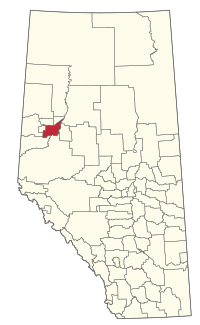Birch Hills County facts for kids
Quick facts for kids
Birch Hills County
|
||
|---|---|---|
|
||

Location within Alberta
|
||
| Country | Canada | |
| Province | Alberta | |
| Region | Northern Alberta | |
| Census division | 19 | |
| Established | 1995 | |
| Area
(2021)
|
||
| • Land | 2,848.75 km2 (1,099.91 sq mi) | |
| Population
(2021)
|
||
| • Total | 1,516 | |
| • Density | 0.5/km2 (1/sq mi) | |
| Time zone | UTC−7 (MST) | |
| • Summer (DST) | UTC−6 (MDT) | |
Birch Hills County is a special type of local government area called a municipal district. It is located in the north-western part of Alberta, Canada. This area is found in Census Division 19, which is just northeast of a larger city called Grande Prairie.
The name "Birch Hills County" comes from a group of hills in the area. These hills were named a long time ago by the Cree Indigenous people.
Contents
History of Birch Hills County
Birch Hills County was officially created in 1995. This means it has been a recognized municipal district for over 25 years!
Exploring Birch Hills County
Towns and Villages Nearby
Birch Hills County is a large area, but it doesn't have any big cities, towns, or villages right inside its borders. Instead, it surrounds some smaller communities.
Hamlets in the County
There are several smaller communities called hamlets located within Birch Hills County. These are like small neighborhoods or settlements.
- Eaglesham
- Peoria
- Tangent
- Wanham – This hamlet used to be a village, but it changed its status in 1999. It's also where the main office for Birch Hills County is located.
- Watino
Other Localities
Besides hamlets, there are also other small places known as localities within the county. These are even smaller settlements or named areas.
- Belloy
- Codesa
- Heart Valley
People Living in Birch Hills County
In 2021, a count of the population showed that 1,516 people lived in Birch Hills County. These people lived in 485 homes. The county is quite large, covering about 2,848 square kilometers (or 1,100 square miles). This means there aren't many people living in each square kilometer, making it a very spread-out and rural area.

